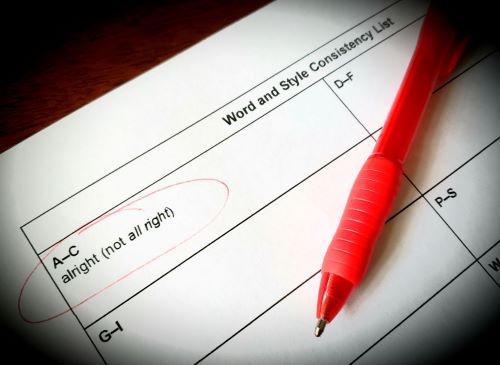I once took a class on book editing, and one of our assignments was to copyedit a section of a manuscript. When the instructor returned my graded assignment, she included the following comment: “I wish you had made more use of the style sheet.”
She was right—I hadn’t made good use of the style sheet, and that was because I didn’t fully understand what style sheets were or how best to use them. I knew the style sheet was a document where I was supposed to record all the editorial decisions I made while copyediting the manuscript, but I was fuzzy on the details.
It wasn’t until I started copyediting manuscripts for Ooligan that I really grasped the concept of the style sheet. I learned that while resources like CMOS, Merriam-Webster, and house style guides are extremely useful when it comes to general rules, there are always going to be exceptions. Every manuscript is different—perhaps you’re working on a book that uses terminology not found in Merriam-Webster, or perhaps the author has some strong stylistic preferences that differ from the publisher’s house style guidelines—and the copyeditor is going to have to make decisions. When this happens, these decisions need to be recorded in the manuscript’s individualized style sheet to ensure consistency.
Imagine this scenario: You’re copyediting a manuscript, and you notice that the author has used the word alright. You suspect that the correct spelling is all right, but when you look it up in Merriam-Webster, you find that both forms are acceptable. Now you have a decision to make. You search the manuscript and find that alright occurs five times, while all right occurs twice. Since the author has shown a slight preference for alright, you decide to go with that spelling. You then turn to the “word list” section of your style sheet, and under “A” (because style sheet entries should always be alphabetized), you type, “alright (not all right).” Now, as you continue the copyedit, every time you run into an alright or an all right, you can refer back to the style sheet to remind yourself of your decision. When you’ve completed this pass, you can search the manuscript for every term on the list to ensure that they’re all being treated consistently. If you didn’t keep a style sheet, maintaining consistency would be much harder.
In addition to word lists, style sheets also include rules for things like punctuation, the use of italics, and the treatment of numbers. For example, a style sheet might specify that all internal thoughts should be expressed in italics. Style sheets for fiction manuscripts should include lists of character names to ensure consistent spelling, and editors should also make note of some distinguishing features for each character. If you note that Billy is described as having blue eyes on page 4, then you’ll notice something is amiss when he suddenly has brown eyes on page 203.
It can be tricky to figure out what to put in a style sheet and what to leave out. You obviously don’t need to list every single rule in CMOS or make an entry for every typo. But what should you include? As Amy Einsohn and Marilyn Schwartz observe in The Copyeditor’s Handbook, it depends on the editor. On page 59 of the recently published fourth edition, they write, “Instead of listing every individual change and decision, experienced copyeditors reduce the work of recordkeeping by simply noting the style followed in certain well-defined categories (e.g., ‘Chicago numbers style throughout’) and then just recording exceptions.… But novice copyeditors should err on the side of overdocumentation until they master the intricacies of various editorial styles.” Include whatever you think might be helpful to you, your managing editor, and the author (who should receive a copy of the style sheet alongside the copyedited manuscript).
Though style sheets can seem confusing at first, they are among the most important tools at a copyeditor’s disposal. As long as you keep your style sheet organized and record all of your decisions related to mechanics and style, you should be all right. (Or is it alright? Better check the style sheet.)

